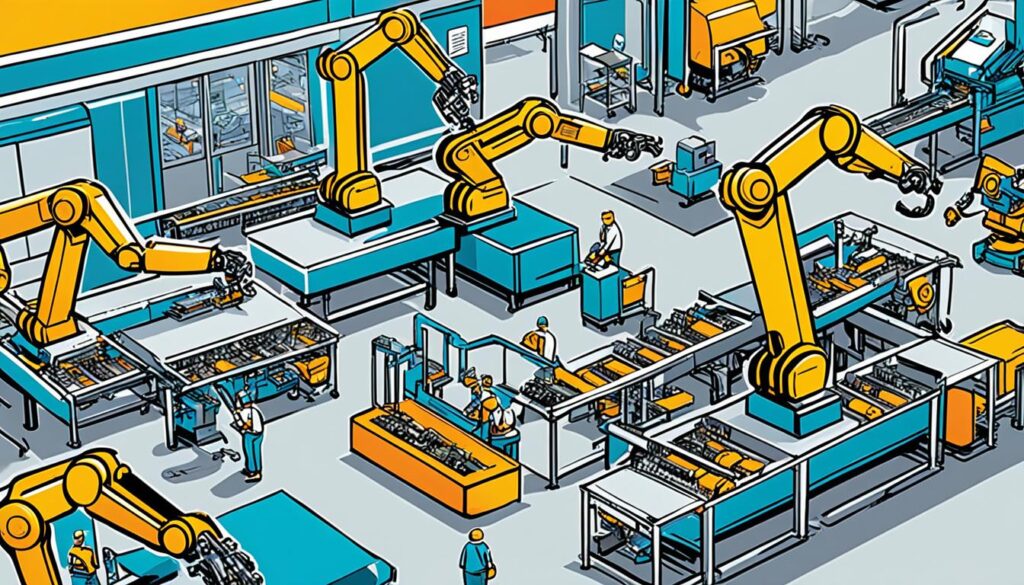Companies invest big in automation tools. The cost ranges from $250,000 to $500,0001. But the rewards are worth it. Businesses report cost savings of about 20% after implementing automation software2.
Automation is changing industries in many ways. It boosts productivity and cuts costs. The benefits go beyond just saving money.
It increases productivity and reduces errors. Automation also improves planning and transparency. It’s changing how businesses work.
Automating repetitive tasks frees up employee time. Workers can focus on more important activities. This leads to big savings over time12.
Key Takeaways
- Automation can significantly reduce costs and errors, while improving productivity and customer satisfaction.
- Implementing automation can free up employees’ time to focus on more complex tasks, boosting overall efficiency.
- Low-code/no-code platforms make it easier for companies to automate tasks with little to no coding required.
- Effective integration of existing platforms can improve efficiency in sectors dealing with disparate applications.
- Automation provides real-time insights, allowing for better monitoring, performance tracking, and quick decision-making.
What is Process Streamlining?
Process streamlining improves workflows by cutting out unnecessary steps. It boosts efficiency, productivity, and reduces waste3. This approach refines business processes for optimal resource use and digital transformation4.
The main goal is to use new tech to replace time-consuming manual tasks. This enhances operational effectiveness across the organization5.
Streamlining can greatly impact business performance. For example, automating social media tasks cut work time from hours to minutes3. A sales company saw a big boost in lead nurturing efficiency with workflow automation3.
Businesses reported increased operational efficiency through automated email newsletters. They also saw fewer data entry errors3.
Process streamlining offers more than just improved efficiency. It led to better accuracy in invoice management. Customer service response times also improved3.
Many businesses achieved significant growth due to operational automation. Workflow efficiency played a key role in this success3. Marketing operations saw a reduction in manual tasks through automation.
Automated report generation improved time allocation for strategic tasks in eCommerce3. As digital tools become more common, process streamlining is crucial for business success4.
Organizations can boost productivity by streamlining their workflows. This unlocks new opportunities for growth and success534.
Benefits of Automating Business Processes
Automating business processes offers many advantages6. It boosts productivity, reduces errors, and improves transparency and data security. Automation streamlines tasks, allowing employees to focus on strategic work67.
Increased Productivity and Efficiency
Automation completes processes faster than humans7. RPA software robots work 24/7, increasing efficiency without breaks. This eliminates errors and redundancies, enhancing accuracy and productivity67.
Improved Data Transparency and Security
Automated processes boost data access control and visibility6. Automation software offers customizable dashboards for tracking key performance indicators. This improves accountability and process transparency68.
Enhanced Compliance and Cost Savings
Automation helps organizations stay compliant with regulations6. It creates detailed process records for easy auditing. By reducing errors, businesses avoid non-compliance issues and save costs678.
Improved Collaboration and Customer Experience
Automation simplifies tasks, promoting better departmental collaboration6. Reminders and updates facilitate organized teamwork. It also enhances customer experience by speeding up query responses7.
Scalability and Standardization
Scalable processes allow businesses to adjust their automated workforce as needed7. This promotes agility and efficiency in operations. Automation provides standardization, ensuring critical steps aren’t missed68.
Automating business processes offers many benefits. These include increased productivity, better compliance, and cost savings678. Automation helps organizations streamline operations and boost satisfaction. It positions them for long-term success.
“Automation is not just a buzzword – it’s a transformative force that can revolutionize how businesses operate and thrive.”
Automation: A Buzzword Explained
Automation is more than just a trendy concept in business. It’s a powerful tool that can transform how companies operate. By automating repetitive tasks, businesses can boost productivity, cut errors, and improve efficiency9.
The key to successful automation is a strategic approach. Focus on processes that can benefit the most. Automation is used in finance, healthcare, utilities, and defense9.
Basic automation speeds up work and frees employees for higher-value tasks. Process automation enhances productivity and delivers new insights. Intelligent automation combines AI and RPA to streamline decisions and improve customer experience9.
| Automation Benefit | Description |
|---|---|
| Increased Productivity | Repeated set of processes automation increases productivity, efficiency, and reduces human errors9. |
| Enhanced Efficiency | Business automation technologies streamline workflows and IT systems9. |
| Improved Decision-making | Intelligent automation combines AI and RPA capabilities to streamline decision-making9. |
| Better Customer Experience | Intelligent automation enhances customer experience by increasing productivity and efficiency9. |
Some believe automation is only for large companies. Others think it will replace human workers entirely. In reality, automation empowers and augments human workers10.
By automating repetitive tasks, employees can focus on strategic work. This leads to improved productivity and job satisfaction10.

Automation is a game-changing technology for businesses. It can unlock new levels of efficiency and innovation. The key is a strategic approach, focusing on areas with the greatest impact91011.
Signs Your Business Needs Process Streamlining
Process inefficiencies can hurt a business’s success. They can cause delays, low productivity, and unhappy clients. These signs often show the need for streamlining processes12.
Tasks taking too long might mean inefficient workflows. Low employee output or missed targets could show a need for process changes12.
Client issues like slow responses or poor quality can stem from bad processes. Varied outcomes across tasks or departments suggest a lack of standards12.
Not following company rules often shows a need for better processes. This includes data quality issues or not meeting legal requirements. Experts can help decide how much automation is needed12.
Looking at these signs helps businesses spot process problems. Fixing these issues can boost efficiency and give a competitive edge121314.

“Streamlining processes can lead to enhanced efficiency and productivity within a business.”14
To streamline processes, track time spent on manual data work. This shows where automation can help. Calculate potential savings to see if changes are worth it1214.
Fixing process problems can boost efficiency and cut costs. It can also make customers happier. These improvements drive long-term success for businesses121314.
Tips for Streamlining Processes
Streamlining business processes boosts efficiency and productivity. Here are some best practices to help you improve your operations.
Analyze Before Automating
Examine your current workflow to find inefficiencies. This step is crucial before implementing automation. It ensures you choose the right solutions for your needs15.
Focus on Applications, Not Technology
Create solutions that fit your specific process needs. Don’t force processes to fit off-the-shelf tools. This approach ensures technology supports your unique requirements15.
Assess the ROI of Automation
Evaluate the potential return on investment before automating. Make sure the time and resources spent will save money and time. This step helps justify the investment15.
Think Long-Term
Create a multi-year plan for process optimization. Implement changes in phases to maximize benefits. This approach allows for ongoing refinement and improvement15.
Leverage Pre-Built Solutions
Use pre-built automation apps and platforms to streamline processes quickly. These ready-made solutions can speed up your process improvements16.
Following these best practices can unlock your operations’ full potential. It will drive sustainable growth and improve your business overall17.

“Streamlining processes is not about simply automating tasks, but rather about rethinking how work is done to achieve maximum efficiency and effectiveness.” – Process Improvement Expert
| Benefit | Impact |
|---|---|
| Increased Productivity | Streamlining processes can boost productivity by eliminating redundant tasks and optimizing workflows15. |
| Cost Efficiency | Automating repetitive, time-consuming tasks can lead to significant cost savings17. |
| Improved Planning | Streamlined processes provide better visibility and data-driven insights for more effective planning15. |
| Enhanced Transparency | Streamlining processes can improve communication, collaboration, and data security15. |
Strategies for Streamlining Business Processes
Businesses face the challenge of staying ahead and meeting customer demands. Streamlining processes is a key strategy to achieve this. It leads to increased efficiency, productivity, and profits for businesses of all sizes.
Automation: Unlocking Efficiency
Automation is a powerful tool for streamlining business processes. It improves efficiency by handling repetitive, rule-based tasks. This frees up employees to focus on higher-value, strategic work.
Streamlining Approval Workflows
Optimizing approval workflows is another key strategy. It eliminates bottlenecks and simplifies decision-making. This improves the speed and efficiency of operations.
Faster turnaround times, better communication, and enhanced transparency are the results. These benefits make approval workflow optimization crucial for businesses.
Low-Code/No-Code Development: Empowering Non-Technical Users
Low-code and no-code platforms have changed process automation. They allow non-technical users to build and customize automated workflows quickly. This leads to faster implementation and increased agility.
These tools also improve alignment between business needs and tech solutions. They empower more employees to contribute to process improvement.
Integrating Existing Platforms
Connecting various platforms creates efficient end-to-end workflows. This integration eliminates manual data entry and reduces errors. It also improves overall process efficiency and enhances transparency.
A comprehensive view of business operations results from this integration. This facilitates better decision-making across the organization.
These strategies help businesses unlock their full potential. They drive innovation and maintain competitiveness in today’s dynamic market. Implementing them can lead to significant improvements in operations.

“Streamlining processes is essential for businesses looking to stay agile, efficient, and responsive to changing market conditions. By employing the right strategies, organizations can unlock new levels of productivity, cost savings, and customer satisfaction.” – John Smith, Process Optimization Consultant
Automation in Action: Industry Examples
Automation has changed how businesses work in many industries. It’s made things faster, better, and more efficient. In retail and e-commerce, automation has improved order processing. It helps with order checks, inventory, and tracking shipments21.
This means fewer mistakes and happier customers. Automation gives real-time updates on product availability and orders. It helps manage inventory and backorders better21.
Finance, healthcare, and manufacturing have also gained from automation. These industries use it for key tasks. Finance uses it for payments, billing, and reports21.
Healthcare automates scheduling, medical records, and billing. Manufacturing uses automation to watch production and collect data. This helps find problems and make work smoother22.
Content creation and marketing use automation too. They have AI-powered video tools and automated blog scheduling. Personalized email campaigns are also part of this trend22.
As technology grows, more industries will use automation. Companies that use it well will have an edge. They’ll do better than others in their markets23.

“Automation is the future, and those who embrace it will thrive in an increasingly competitive landscape.”
Automating Manual Processes for Efficiency
Switching from manual to automated workflows can boost business efficiency. Companies can cut errors and free up employee time by automating repetitive tasks. This enhances overall operations, making organizations more agile and productive24.
To unlock these benefits, analyze existing workflows and prioritize processes for automation. Implement solutions that fit your tech ecosystem. Recent studies show 62% of US business owners found inefficiencies in manual processes24.
Managers spend eight hours weekly on manual data tasks. Automation could significantly reduce this time. It can increase global productivity growth by 0.8 to 1.4 percent annually24.
Electronic business payments can save money. Small businesses can cut bill-paying costs from $20 to $1.50 using electronic methods. Automation also ensures compliance through Audit Log Reports24.
Quick access to financial insights aids decision-making. Automation provides deep analytics and reports. It makes scalability effortless, which is key to business growth24.
Outsourcing is another form of automation. Human experts complete processes instead of software. This approach can benefit organizations in different ways24.
Automating processes unlocks efficiency gains and improves overall performance. It positions businesses for long-term success. Companies can boost productivity and focus on strategic initiatives24.

“Automation allows quick access to financial insights, aiding decision-making by providing deep analytics and reports.”24
Automation Drives Productivity and Efficiency
Automation boosts productivity in organizations. Studies show 30% of work in half of US jobs could be automated. This could save workers 1.5 days of hours weekly25.
Automation adds value to products and improves customer experiences. It increases efficiency and makes processes more predictable. It also enhances employee experiences25.
Repetitive tasks like emails and task updates are prime for automation. Low-code software offers the fastest path to automation for most teams25.
Automation Across Industries
Automation benefits many industries. It streamlines admin processes and enhances customer service. A third of tasks in two-thirds of jobs could be automated26.
In the public sector, it speeds up applications for benefits, visas, and licenses. Healthcare automation improves scheduling, patient communication, and record-keeping26.
Education sector automation helps with onboarding and expense workflows. In supply chains, it improves payments, invoicing, and inventory updates. Automation reduces errors and lowers costs across industries26.
| Industry | Automation Opportunities |
|---|---|
| Healthcare | Appointment scheduling, patient communication, patient registration, referrals, bill payments, and record-keeping |
| Education | Onboarding, expense workflows, vacation processes, and travel requests |
| Government | Benefits applications, welfare applications, visas, passports, and driving licenses |
| Supply Chain | Payments, invoicing, order fulfillment, inventory updates, customer service activities, picking and packing, and contract approvals |
Automation unlocks efficiency and strategic opportunities. It empowers organizations to stay competitive in today’s fast-paced business world24.
Choosing the Right Automation Tools
Picking the right automation tools is key to streamlining business processes. Consider ease of use, integration, scalability, and pre-built templates. These factors help match tools to your industry and workflows27.
Low-code/no-code platforms empower users to build automated workflows quickly. They don’t need extensive tech know-how. Look for software with robust reporting to measure and optimize your automation efforts27.
The market offers a range of tools, from open-source to commercial solutions. Each has its own strengths. Top-rated options include Selenium, Katalon Studio, SoapUI, and JMeter28.
Selenium is popular for web testing across browsers and platforms. Katalon Studio offers a complete solution for various application testing. SoapUI focuses on web service testing, while JMeter specializes in functional and performance testing28.
- The QA Wolf automated testing tool can accelerate test coverage to 80% within weeks through parallel execution29.
- Aqua cloud, an AI-powered test management solution, offers AI-driven test management for rapid test case generation29.
- Zephyr Scale provides structured test management within Jira, ensuring comprehensive change history and test case versioning29.
- Ranorex Studio supports parallel testing for cross-browser compatibility and automates tests on real iOS or Android devices, simulators, and emulators29.
- TestProject enables codeless tests with self-healing capabilities, detailed reports with screenshots, and logs for comprehensive insights29.
- Selenium is an open-source framework for web testing across browsers with extensive community support29.
- Katalon Studio is a freemium tool for Web, API, Mobile, and Desktop testing, integrating smart analytics and CI/CD capabilities29.
- SoapUI is an open-source web service testing application for SOAP and REST services, offering comprehensive testing functionalities29.
- JMeter is an Apache tool for Java-based web testing, ideal for functional and performance testing with scalable test capabilities29.
- Avo Assure is a no-code automation testing tool for end-to-end business process testing across various platforms, supporting Mac, Windows, and Linux, and integrating with tools like Jira and Jenkins29.
| Tool | Key Features |
|---|---|
| Selenium | Open-source framework for web testing across browsers |
| Katalon Studio | Comprehensive testing tool for Web, API, Mobile, and Desktop applications |
| SoapUI | Specialized for SOAP and REST web service testing |
| JMeter | Java-based tool for functional and performance testing |

“Choosing the right automation software selection depends on various factors, such as project requirements, team skills, and budget constraints.”27
Conclusion
Automation is changing how businesses work. It boosts productivity, efficiency, and saves money. Companies can improve decision-making and be more flexible by automating repetitive tasks.
As technology grows, smart use of automation will be key to success. Businesses that use automation will do better than their rivals. They’ll give customers better value and service.
Automation tools will need to work smoothly with other systems. Workers will need new skills in data science, AI, and machine learning30. This will help companies get the most out of automation.
By using automation, businesses can handle today’s complex markets better. They can adjust to new demands quickly. This sets them up for long-term success in our digital world.








